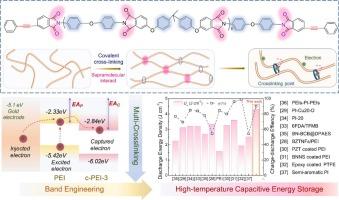协同多交联和带隙工程提高了高温聚合物电容器的性能
IF 8.9
2区 工程技术
Q1 ENERGY & FUELS
引用次数: 0
摘要
高温介质聚合物由于热激活的载流子输运和不可逆的机电击穿,在电容储能方面面临着固有的限制。在这里,我们提出了一种分子设计模式,涉及聚醚酰亚胺(PEI)与π共轭苯乙酰基基团的末端功能化,构建了具有双重功能的多交联网络:升高的玻璃化转变温度(Tg = 242℃)限制了链段在热电应力下的迁移率;密度泛函理论表明,π共轭三键与传统PEI相比,扩大了带隙,建立了深电荷阱(导电带以下0.6 eV),抑制了载流子注入动力学。优化后的薄膜在150°C时达到了573.8 MV m−1的超高击穿强度(比原始PEI高46%),泄漏电流降低了两个数量级,在90%的效率下,放电能量密度达到4.3 J cm−3,超过了商用高温电介质。这种分子工程策略为通过原子尺度的电子结构调制和大分子构象控制来开发极端条件下的电容材料提供了一个可推广的框架。本文章由计算机程序翻译,如有差异,请以英文原文为准。

Synergistic multi-crosslinking and bandgap engineering elevate high-temperature polymer capacitor performance
High-temperature dielectric polymers face inherent limitations in capacitive energy storage due to thermally activated carrier transport and irreversible electromechanical breakdown. Here, we present a molecular design paradigm involving terminal functionalization of polyetherimide (PEI) with π-conjugated phenylacetyl moieties, constructing a multi-crosslinked network with dual functionality: an elevated glass transition temperature (Tg = 242 °C) restricts chain segment mobility under thermal-electrical stress; Density functional theory reveals that π-conjugated triple bonds widen the bandgap compared to conventional PEI, establishing deep charge traps (0.6 eV below conduction band) that suppress carrier injection kinetics. The optimized films achieve an ultrahigh breakdown strength of 573.8 MV m−1 at 150 °C (46 % above pristine PEI) with leakage current reduced by two orders of magnitude, enabling a discharged energy density of 4.3 J cm−3 at 90 % efficiency, surpassing commercial high-temperature dielectrics. This molecular engineering strategy provides a generalizable framework for developing extreme-condition capacitive materials through atomic-scale electronic structure modulation and macromolecular conformation control.
求助全文
通过发布文献求助,成功后即可免费获取论文全文。
去求助
来源期刊

Journal of energy storage
Energy-Renewable Energy, Sustainability and the Environment
CiteScore
11.80
自引率
24.50%
发文量
2262
审稿时长
69 days
期刊介绍:
Journal of energy storage focusses on all aspects of energy storage, in particular systems integration, electric grid integration, modelling and analysis, novel energy storage technologies, sizing and management strategies, business models for operation of storage systems and energy storage developments worldwide.
 求助内容:
求助内容: 应助结果提醒方式:
应助结果提醒方式:


